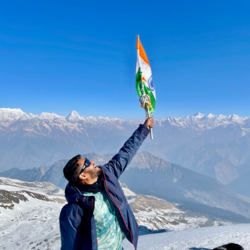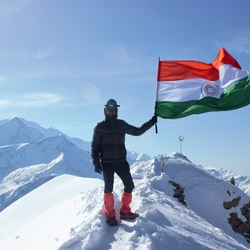In the past and even today, when we look at mountains, their sheer size and magnificence make us feel that we are standing in the presence of something …Godlike. They are believed to be the homes of Gods. Some cultures still believe that meditating in these places is a way of getting closer to God and acquire moksha or nirvana.

Why am I talking about peaks and their connection to myths and beliefs? Because the Garhwal Himalayas are full of such stories. Majority of the peaks are even named after Gods.
Before showing you the peaks visible from Kedarkantha top, let me tell you the myth about Kedarkantha itself.
The story of Lord Shiva on Kedarkantha
The locals tell various tales about Lord Shiva’s attachment to Kedarkantha. Legend has it that Lord Shiva sat on top of the peak for meditation but due to disturbances from the local villages in the vicinity, ended up abandoning it and moved to Kedarnath instead. There is a small shrine at the top of Kedarkantha dedicated to Lord Shiva to add life to this tale. On a connected note, the view from the top of this peak might have had something to do with why Shiva chose this site in the first place!

While the summit of Kedarkantha opens up a wide view that accommodates countless peaks in the region like Nanda Ghunti, Yamunotri range, Gangotri range, Draupadi ka Danda and many more, here are the three most prominent ones you see and clearly recognize from the top:
Swargarohini Peaks I-IV (6,252M):
Swargarohini is the crown of the Garhwal Himalayas. You will see this magnificent peak throughout the Kedarkantha trek, and even from Sankri. It consists of four peaks Swargarohini I, II, III and IV - given its unique shape, it is one of the most attention-grabbing peak in Uttarakhand.
THE LEGEND BEHIND SWARGAROHINI:
Swagarohini derives its name from the legend that states that its peaks lead the way to heaven, a path which was taken by the Pandavas. Swarg means heaven and rohini is a word for way/path. This means Swargarohini literally translates to a direct way to heaven. During the final push to the top of Swargarohini, on their way to heaven, 4 of the 5 Pandava brothers perished on the way along with Draupadi. The only one to make it to the top was Yudhishthira. He is believed to have reached heaven in human form.

Kalanag and Bandarpoonch (6,387M and 6,316M):
Kalanag is another peak with a very unique shape. It gets its name because the top part resembles the hood of a black cobra or the serpent God. It lies within the Bandarpoonch mountain range and is also called ‘The Black Peak’.
On the other hand, Bandarpoonch gets its name from Hanuman, the monkey God and a mighty warrior in Hindu mythology. Bandarpoonch literally means the Tail of a monkey. What's fascinating about Bandarpoonch is its climbing history.
Did you know Tenzing Norgay, the Sherpa who was part of the first known team to reach the summit of Mt. Everest in 1953, had summited Bandarpoonch first? The legendary mountaineer was part of the first team to ever summit Bandarpoonch back in 1950. He surely has a lot of firsts to his name!

Apart from these, you will also see the Gangotri and Yamunotri mountain ranges, Rupin Valley and Har Ki Dun valley from the top.
The views from the top are insanely beautiful. It's hard to describe what it's like to see nature’s best creations all around you.
I’d urge you to come and witness this magnificence for yourself!
This article was originally written by Pooja Dhiman on 06-02-2018.
It was edited and updated by Neeti Singhal on 4-10-2023.






